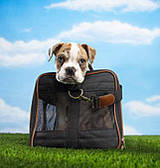 |
| Dog carrier |
A dog carrier offers a convenient way to transport the puppy or your adult dog. Dog carrier will still provide security for your dog and also you as the owner. When choosing a dog carrier there are important things that need to be considered first. After that all are met, you can find the appropriate style and personal taste. There are several styles, materials and size of dog carrier you can choose, some suitable only for small breed dogs only, while others can accommodate any size dog.
The things you want in the dog carrier is:
durable, easy to clean, easy to use, can be used for air or sea travel, lightweight and stable. Your dog carrier also must have a mechanism for secure closure and lots of air holes or windows. Your dog carrier should make your dog feel safe and comfortable. Of course, a dog carrier that attractive and can be changed as you wish it had its own added value. The size of your dog carrier dog should match the size of your dog. Last but nonetheless important is the dog carrier must have a clear warranty.
To help you choose the perfect dog carrier for your dog, consider the following factors:
1. Determine what the main purpose of dog carrier
If you would often bring your dog, lightweight carrier that is the most fitting choice. If the carrier will be more frequently used at home, you should choose a carrier that is more heavy and bulky. If a dog carrier will be used for air or sea travel, you need to use a solid plastic carrier with wire door, depending on the airline regulations. If you have a small dog, you might want to carriers which looks more like a handbag so you can carry your dog everywhere.
2. Consider the size of your dog
Dog carriers come in various shapes and sizes. Most dog carrier will include height and weight type of dog that would be appropriate for the carrier. It is recommended that the dog carrier has enough room for the dog stand up and roll over without difficulty and felt cramped.
- Dog carriers for small dogs
 |
| Small dog carrier |
If you have a breed of small dog, the dog-shaped carrier bag most suitable for use. These types of dog carriers like the bag was taken as usual. Some models allow you to strapped into car seats, making travel by car is safer for your dog. Another common type is the dog carrier in the form of backpacks. You can use a dog backpack carrier for dogs which is slightly larger and some models can be converted into car seat for a dog. There is also another option called a sling. It has features that are associated shoulder strap, storage pouch, and the bottom is soft and comfortable. It's made of sturdy nylon fabric and can accommodate dogs weighing up to 10 kg.
- Dog carriers for big dogs
 |
| Big dog carrier |
For larger dogs, you have three choices:
a portable crate, plastic crate, and crate wire. They used not to carry but to transport your dog by car / plane / ship. Portable Crate is made of soft material and can accommodate a dog whose size is too big for the duffel bag or backpack. Some of the commercially available portable crate had a handle. Because of very light, and when folded does not meet the place, portable crate is easy to use while traveling.
Plastic crate similar to a portable crate, only they are made of hard plastic. They come in various sizes and not like other dog carrier, plastic crate can be used to transport a dog on the plane because it met the flight rules for pet travel domestically and internationally.
A wire crate is not really defined as a carrier in the sense you carry it, but rather the means to carry or move the dog in the journey by car. This provides security not only for your dog, but also for the drive. Crate wire offers visibility and better ventilation, it is much easier to clean, and more durable when compared with the two previous crate.
3. Check the carrier material made of what
 |
| Dog carrier material |
Carrier made of various materials ranging from plastic, mesh, metal or a soft cloth. If your dog likes to chew, you may be better to buy a carrier that is made of metal or plastic rather than soft cloth or net. If your dog handle the situation better if can not see around it, the carrier made from solid plastic or solid fabric to choose from. Carrier that easy to clean is made from plastic and metal. A carrier made of fabric may need to be washed with soap or rinse with a hose when dirty. There are certain dog carrier made of a kind of cardboard paper and is much more sturdy and durable than plastic. If the carrier is to be wet so they can easily be destroyed or damaged. It is advisable for you to not use a carrier that is made from this material.
4. Check the design and quality
 |
| Design and quality of dog carrier |
5. Think about your dog's comfort
If your dog screaming, shaking and trying to jump out of the carrier you choose, he may need a little help from you to know that the carrier makes the trip more enjoyable and safe. Teach your dog that the carrier is a safe place. Start by placing treats in the carrier and allow him to jump into the bag to retrieve treats. Place it gently on the carrier. With whom he talked and joked each time you put into the carrier. Take time beforehand to familiarize the dog in the carrier before taking it by using the carrier road.


























